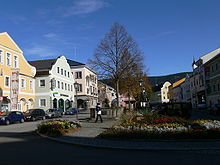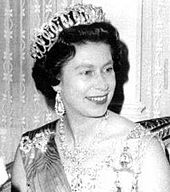- Nicholas Treadwell
-
Nicholas Treadwell (born 1937 or 1938[1]) owns the Nicholas Treadwell Gallery, which started in 1963 in touring vehicles, after which it was run in buildings in London, Bradford and finally Austria. Treadwell has promoted the Superhumanism art movement, which is defined as an art of urban living, conveyed in a vivid and accessible way. At times, his shows have evoked strong reactions for their provocative content.
Contents
Life and career
Nicholas Treadwell was born in the United Kingdom.[2] In 1963,[3] he toured England with a double-decker bus and two furniture vans as mobile galleries,[4] as "Nicholas Treadwell's Mobile Art Gallery", based in Croydon.[5]
In 1968, he established the Nicholas Treadwell Gallery at 36 Chiltern Street, in the West End of London,[3] and lived in one of the rooms in the basement.[6] Against the contemporary trend of Hard-edge abstraction and Minimalism, the gallery focused on "the basic nature of the human condition",[7] and quickly gained a controversial reputation.[7] In 1971, Art and Artist magazine said of one show: "The place blisters with work of searing eroticism, high camp, coarse belly laughs and hideous vulgarity".[7]
In 1975, Treadwell asked 29 artists to submit a new approach to what he termed the normal "academic and dull" portraits of Queen Elizabeth.[1] The results showed her hand-in-hand with Henry VIII, rowing a boat and drinking from a Union Jack mug.[1] Treadwell said that business with tourists had been good, but he did not invite the Queen to the show, because "I see them as very affectionate portraits, but I don't know how she would see them".[1]
In 1978, he acquired Denne Hill, a mansion with 52 rooms, designed by George Devey and built in 1871–75,[8] in Womenswold between Canterbury and Dover; restoration took two years but it was opened to the public in July 1980.[9] Denne Hill provided studios for artists and accommodation for visitors; Treadwell ran it alongside the London gallery until 1984.[3]
The Chiltern Street gallery was key to the launch of the Superhumanism (or Super Humanism) movement,[6] which is defined as "art about people, people living the life of an urban society",[7] and about which Treadwell wrote the first book in 1979.[6] He published a second book on Superhumanism and promoted the movement through exhibitions in the United Kingdom and on the continent.[3] Ben Moss, in his book Four Funerals and a Wedding, wrote:
The actual imagery of the superhumanists, while striking, and sometimes shocking, reflected the contemporary feelings of the Western experience. It was preoccupied with daily life, with the characters of the street, or characters of an obtuse nature, and with scenes depicting the emotions, stresses or potential perversions lying within each of us. The artists, while portraying their ideas in aesthetically different ways, shared a desire to convey the moving nature of their subject matter in an understandably vivid manner. A philosophical acceptance of human weakness was an important characteristic of superhumanist art, but humour, cynicism, pessimism and anger were also present, along with an almost sad observation of the human condition, emotions which were the driving forces behind some of the movement's most striking imagery.[7]
In 1981, Treadwell's stand at the FIAC (Foire Internationale d'Art Contemporain) at the Grand Palais in Paris was deemed "deplorable and very popular" by Richard Shone in The Burlington Magazine.[10]
In 1984, Treadwell left Chiltern Street,[6] and in 1987[3] opened Treadwell's Art Mill for Superhumanist work in a three-storey former wool mill in Little Germany, Bradford.[3][4][11] The Art Mill provided residency space for 14 artists, as well as a theatre, a cinema and a vegetarian cafe.[4] Treadwell was particularly interested in supporting artists in their first few years out of college, when he felt it was important to encourage them not to compromise with their work.[4] He opposed the "posh shop—where a few rich people help a few artists get rich."[4] The building, erected in 1847, was visited by 25,000 people, but increasing debts forced Treadwell to put it up for sale by 1991.[12]
 Old Street, East London: the Nicholas Treadwell Gallery was located there in 1996.
Old Street, East London: the Nicholas Treadwell Gallery was located there in 1996.
By 1996, The Nicholas Treadwell Gallery was at 326 Old Street, London.[13] His own home was described as "littered" with paintings and sculptures, some by an anorexic artist who had died the previous year—one of these showed a small body huddled inside a wardrobe, in the bottom drawer of which the artist had placed her adoption papers.[13] Treadwell said her sculptures were "very depressing but they do give you insight into the illness."[13]
In 1998, John Windsor in The Independent said that the work of the Young British Artists seemed tame compared with that of the "shock art" of the 1970s, including "kinky outrages" at the Nicholas Treadwell Gallery, amongst which were a "hanging, anatomically detailed leather straitjacket, complete with genitals", titled Pink Crucifixion, by Mandy Havers.[14]
In January 2000, The Treadwell Gallery moved to Die Station, a set of buildings fronting a river near to the Bohemian Woods in Upper Austria.[3]
In 2004, The Guardian art critic Adrian Searle reviewed Mike Kelley—The Uncanny at Tate Liverpool.[15] In the show were "super-realist" sculptures from the 1960s and 70s, many of which were by artists represented by what Searle called "the peculiar Nicholas Treadwell Gallery" and which he "had hoped never to see the first time, let alone again."[15]
Treadwell wrote a letter to The Guardian saying that Searle's "dismissive language in relation to major works by the visionary artists Robert Knight and Malcolm Poynter, for instance, is inexplicable".[16] This was followed by a letter from John Keane, who said that galleries such as Treadwell's, outside an establishment coterie, were inevitably met with "a dismissive sneer" by critics who acted as a herd.[17]
 The Marktplatz of Aigen, where the Nicholas Treadwell Gallery moved in 2005
The Marktplatz of Aigen, where the Nicholas Treadwell Gallery moved in 2005
In January 2005, Treadwell moved to the courthouse and prison buildings in the Mühlviertel village of Aigen, near the borders of Germany and the Czech Republic.[3]
Work has been bought from Treadwell by John Entwistle, Paul McCartney and Malcolm Forbes.[4]
References
- ^ a b c d "People", Time, 15 September 1975. Retrieved 14 August 2010.
- ^ "Treadwell's gallery", Almesberger. Retrieved 14 August 2010.
- ^ a b c d e f g h "Past locations", Superhumanism. Retrieved 14 August 2010.
- ^ a b c d e f Cassidy, Suzanne. "Style Makers; Nicholas Treadwell: Art Dealer", The New York Times, 24 June 1990. Retrieved 14 August 2010.
- ^ According to the painting on the bus, as shown in a 1965 photograph reproduced in the (unpaginated) introduction to Super Humanism: A British Art Movement (London: Nicholas Treadwell Books, 1980).
- ^ a b c d Treadwell, Nicholas. "Superhumanism", Superhumanism, 2010. Retrieved 14 August 2010.
- ^ a b c d e Moss, Ben (2009). Four Funerals and a Wedding, p.185, Janus Publishing. ISBN 1857566297, ISBN 978-1857566291. Accessible via Google Books.
- ^ Age and designer of Denne Hill: Mark Girouard, The Victorian Country House (New Haven: Yale University Press, 1979; ISBN 0-300-03472-5), p.403.
- ^ Treadwell, Nicholas. (N.d.) Superhumanism ... a Feeling for Our Times. London: Nicholas Treadwell. P.133 and back cover.
- ^ Shone, Richard. The Burlington Magazine, Vol. 123, No. 945, pp.758+761-762+767, December 1981. Retrieved from Jstor, 14 August 2010.
- ^ Although Cassidy says a cotton mill Treadwell says a wool mill; Bradford used to be a wool city. "Bradford Historical Attractions", visitbradford.com. Retrieved 14 August 2010.
- ^ "Rubble at t'mill—as £2.4m revamp starts", Telegraph and Argus, 13 January 2003. Retrieved 14 August 2010.
- ^ a b c Rouse, Rose. "Arts: This man collects art to put in his loft", The Guardian, p.T.010, 25 November 1996.
- ^ Windsor, John. "Art 98: Collecting—Let the love affair begin", The Independent, 17 January 1998. Retrieved 14 August 2010.
- ^ a b Searle, Adrian. "Visual Arts: Inside the mind of an insane collector", The Guardian, G2 p.12, 24 February 2004. Retrieved 14 August 2010.
- ^ Treadwell, Nicholas. "Art attack", The Guardian, p.25, 9 March 2004. Retrieved 14 August 2010.
- ^ Keane, John. "Art on Tharg", The Guardian, p.23, 13 March 2004. Retrieved 14 August 2010.
Further reading
- Treadwell, Nicholas. (1980). Super Humanism: A British Art Movement. London: Nicholas Treadwell Books. Introduction by Michael Shepherd, edited by Paul Foster.
- The artists introduced are Roy Abernethy, Albert Alexander, Jane Anderson, Saskia de Boer, Jo Bondy, Chris Brown, John Buckley, Nick Cudworth, Graham Dean, Rod Dudley, Ian English, Mike Francis, David Giles, Guy Gladwell, Mike Gorman, Mandy Havers, Steve Hodges, Harry Holland, Graham Ibbeson, Robert Knight, Neil Moore, Mike Mycock, Malcolm Poynter, Paul Roberts, David Roft, Eric Scott, Ludmil Siskov, Nigel Thompson, Celestino Valenti, Andre Wallace.
- Treadwell, Nicholas. (n.d., c.1981/1982) Superhumanism ... A Feeling for Our Times. London: Nicholas Treadwell Publications. ISBN 0-907932-00-2 (hard), ISBN 0-907932-01-0 (paper). On the front cover: Superhumanism 2 (S-oohpaahhumanismmm): A Survey of a Current Art Movement.
- The artists introduced are Roy Abernethy, Jane Anderson, Saskia de Boer, Jo Bondy, Chris Brown, Jon Buck, John Buckley, Barry Burman, Nick Cudworth, Graham Dean, Ian English, Mike Francis, David Giles, Guy Gladwell, Mike Gorman, Gordon Govier, Mandy Havers, Harry Holland, Graham Ibbeson, Robert Knight, Neil Moore, Mike Mycock, Howard Pemberton, Malcolm Poynter, Paul Roberts, David Roft, Eric Scott, Ludmil Siskov, Celestino Valenti, Andre Wallace.
- Treadwell, Nicholas, ed. (1984) Sex: Female, Occupation: Artist. Womenswold, Kent: Nicholas Treadwell Publications. ISBN 0-907932-02-9.
- Treadwell, Nicholas, ed. (1984) Malcolm Poynter: Sculpture and Theatre. Womenswold, Kent: Nicholas Treadwell Publications. ISBN 0-907932-03-7.
External links
Categories:- British art dealers
- Living people
- 1963 establishments
- Contemporary art galleries in the United Kingdom
- Year of birth uncertain
Wikimedia Foundation. 2010.


